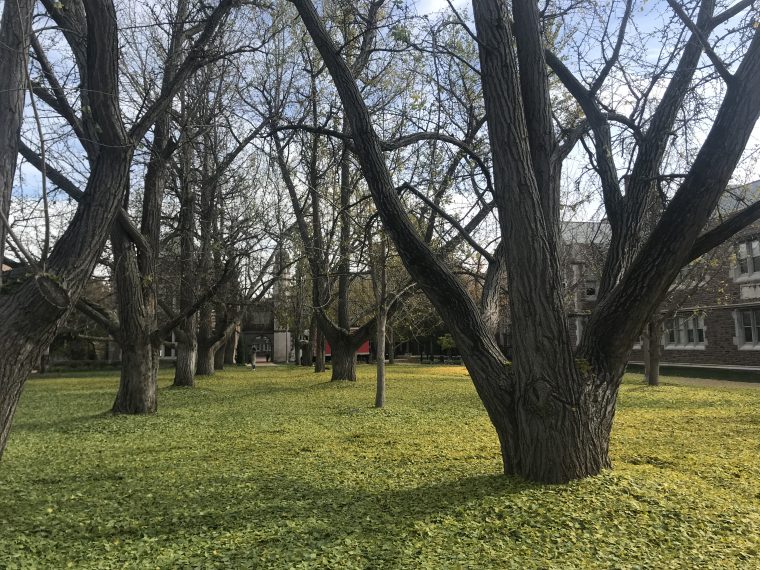Scene
‘That beautiful carpet’: A walk through Ginkgo Allée
Walking through Ginkgo Allée on the eastern side of Olin Library after the leaves have fallen is an experience in itself. The leaves form a yellow-green carpet, turned golden in the sunlight, and crinkle gently with every step. On both flanks, the almost-centenarian ginkgo trees have lost their leaves, but not their majesty, and they stand tall, bare and proud. The scene is both serene and beautiful, but, even though the leaves fell just last Thursday night, Nov. 7, they’ll be gone before the month is out.
 Photo by Mo Kleinhenz
Photo by Mo Kleinhenz Generally, most students and other members of the Washington University campus prefer the foliage to remain on the ground for as long as possible. Hannah Richter is a senior studying English with a concentration in Creative Writing who has previously written an op-ed published by the Office of Sustainability calling for the preservation of the ginkgo leaf carpet. She believes the beauty of the leaves is a reminder to the student body to slow down and appreciate the small things of life.
“I felt as though we had a duty to to hold on to that sort of beauty for as long as we could, and not prematurely ‘clean up’ the proverbial lawn,” she said. “In rigorous academic environments, so often does the student body forget to be present, and I felt this shock of yellow was just one of many ways to remember to be alive.”
However, every year, the leaves from the Danforth Campus’ 86 ginkgo trees are removed from the ground within a few weeks, without fail. Chris Anderson, Wash. U.’s Grounds & Landscape Design manager, also appreciates their beauty, but also recognizes the need to clean the leaves when necessary.
“We’re going to let them go as long as we can,” he said. “When their color starts to fade we’ll pick them up, but until then we’ll let that beautiful carpet be. The only reason I would remove them is if it became a safety issue or something like that on the sidewalks. No, we love the color. It’s awesome. A lot of people will come here to take pictures if they’re having a wedding at Graham Chapel and the students love it, so we’ll leave them be.”
Ginkgo Allée is a historic part of Wash. U.’s campus, as an integral “part of the original 1927 Cope and Stewardson plan for the University campus,” according to the University’s website on campus trees. The walk inspired the late Pulitzer Prize-winning poet and University professor Howard Nemerov to write his poem “The Consent,” published in The New Yorker in 1974.
“Those trees…go hand in hand with our initial structures and buildings,” Anderson said. “They kinda go way back to the early 1900s and they just tell a story of how this campus evolved and, man, it’s like Brookings and Ginkgo Allée, it’s just fantastic. It’s such an icon here.”
Not only do the ginkgo trees have aesthetic and historic value, they also play a big part in environmental efforts on campus.
“Trees provide a number of ecosystem services,” Wash. U.’s sustainability manager, Cassie Hage, said. “…So things like increasing the air quality [and] filtering the air, catching stormwater runoff and holding it on site, those are probably the biggest…They provide habitat for animals as well.”
So how much exactly do these trees benefit the campus? The National Tree Benefit Calculator estimates that each mature ginkgo tree with a diameter of 25.5 inches provides benefits worth $70 annually. The difference between the large, ancient ginkgos and other smaller trees on campus is made even more clear when compared to the much smaller Saratoga Gingkos, which only offer benefits of $10 annually.
So, if you haven’t seen the most famous natural phenomenon yet, going to Gingko Allée as soon as possible seems to be a good bet. After all, according to Chris Anderson, “it could sometimes be two, two and a half weeks, three sometimes” before the leaves are removed for good, not to return again for another full year. What better way to celebrate this last hurrah of fall?
